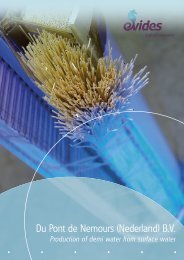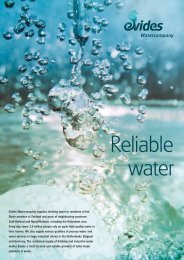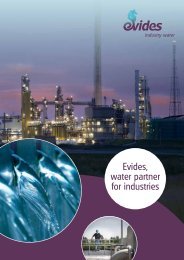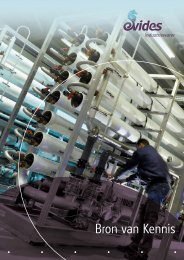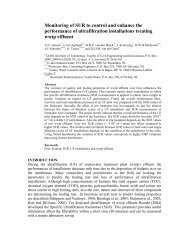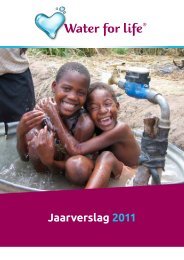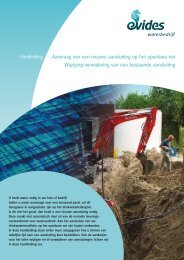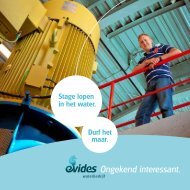Airlift MBR at Municipal WWTP Terneuzen for Industrial ... - Evides
Airlift MBR at Municipal WWTP Terneuzen for Industrial ... - Evides
Airlift MBR at Municipal WWTP Terneuzen for Industrial ... - Evides
You also want an ePaper? Increase the reach of your titles
YUMPU automatically turns print PDFs into web optimized ePapers that Google loves.
Introduction Project Scope<br />
• The municipal wwtp <strong>Terneuzen</strong> is oper<strong>at</strong>ed by W<strong>at</strong>er Authority<br />
‘Zeeuws-Vlaanderen’ in the Netherlands.<br />
• Present capacity of the wwtp is 77,500 Pollution Equivalents.<br />
• The plant was built in 1990, several extensions took place over<br />
the years to meet stricter requirements <strong>for</strong> N- and P-removal.<br />
• Since 2007 a volume of 5,000 m 3 per day of effluent is tre<strong>at</strong>ed<br />
by <strong>Evides</strong> Industry W<strong>at</strong>er to produce demineralised w<strong>at</strong>er <strong>for</strong><br />
reuse <strong>at</strong> Dow Benelux.<br />
• It is the first example of a combin<strong>at</strong>ion of industrial and munici-<br />
pal wastew<strong>at</strong>er <strong>for</strong> reuse on a large scale in the Netherlands.<br />
The wwtp of <strong>Terneuzen</strong>,<br />
including the projected<br />
upgrading with an airlift <strong>MBR</strong><br />
Principle of the NORIT air lift <strong>MBR</strong><br />
Bioreactor<br />
and Objectives<br />
• Upgrading is needed in the near future <strong>for</strong> improvement of the<br />
effluent quality.<br />
• The volume of effluent reuse has to be doubled be<strong>for</strong>e in 2010.<br />
• The <strong>Terneuzen</strong> wwtp will be upgraded with an <strong>MBR</strong> system in<br />
the year 2009.<br />
• The <strong>MBR</strong> system will have a nominal hydraulic capacity of<br />
400 m 3 /hr and a maximum hydraulic capacity of 620 m 3 /h.<br />
• The perme<strong>at</strong>e from the <strong>MBR</strong> will not be discharged into the<br />
environment, but fed to an RO membrane unit <strong>for</strong> further<br />
polishing and reuse as boiler feed w<strong>at</strong>er.<br />
• To increase the hydraulic load to the <strong>MBR</strong>, clarifier overflow<br />
of the existing wwtp will be added to the <strong>MBR</strong>.<br />
• Currently a NORIT <strong>MBR</strong> <strong>Airlift</strong> pilot plant is oper<strong>at</strong>ed and<br />
gener<strong>at</strong>es process d<strong>at</strong>a to service the engineering <strong>for</strong> the<br />
full scale <strong>MBR</strong> plant.<br />
• Objectives <strong>for</strong> the pilot scale research are determining the<br />
feasibility of different effluent addition schemes and the<br />
maximum and oper<strong>at</strong>ional membrane flux.<br />
• In rel<strong>at</strong>ion to the production of demineralised w<strong>at</strong>er the<br />
requirements <strong>for</strong> the perme<strong>at</strong>e are 10 mg/l <strong>for</strong> N-total and<br />
2 mg/l <strong>for</strong> P-total.<br />
Membrane feed<br />
Air release<br />
Air lift<br />
Chemical cleaning<br />
Backwash<br />
Perme<strong>at</strong>e<br />
Pilot plant<br />
Influent 80%<br />
Effluent<br />
1,000-<br />
3,100 m 3 /h<br />
20%<br />
<strong>MBR</strong><br />
Future situ<strong>at</strong>ion after upgrading the wwtp with the <strong>MBR</strong><br />
Addition clarifier overflow<br />
M<strong>at</strong>erials<br />
and Methods<br />
• Both the full scale and the pilot plant are equipped with<br />
<strong>Airlift</strong> <strong>MBR</strong> by NORIT Membrane Technology (Enschede,<br />
The Netherlands).<br />
• The NORIT airlift has its first full scale applic<strong>at</strong>ion <strong>at</strong> the wwtp of<br />
the town of Ootmarsum, The Netherlands (Futselaar et al, 2007).<br />
• The pilot plant has a hydraulic capacity of 3 m 3 /h.<br />
• The maximum gross flux amounts to 50 l/m 2 *h.<br />
• Iron(III)chloride is added to the <strong>MBR</strong> <strong>for</strong> chemical P-removal<br />
• For determining the sludge quality the Delft Filtr<strong>at</strong>ion<br />
Characteriz<strong>at</strong>ion Method (DFCM) method has been used<br />
(Evenblij et al, 2005)<br />
<strong>Industrial</strong> reuse<br />
400-620 m 3 /h





